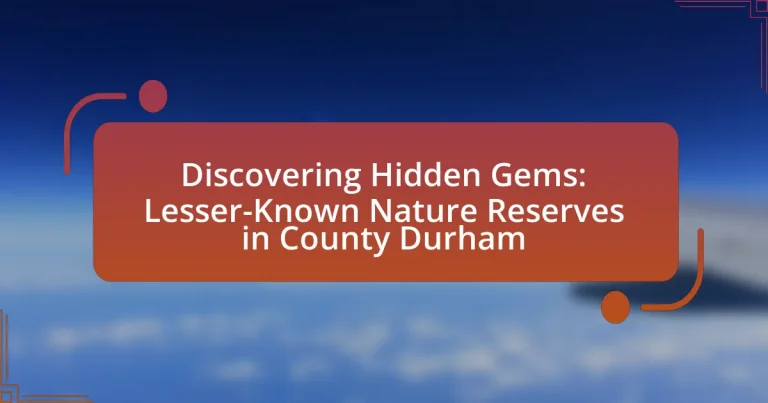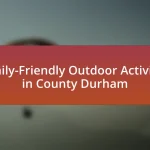The article focuses on the lesser-known nature reserves in County Durham, highlighting their ecological significance and recreational opportunities. Key reserves discussed include Low Barns Nature Reserve, Teesdale Nature Reserve, and the Derwent Valley, each offering unique ecosystems and habitats that support diverse wildlife. The article emphasizes the importance of exploring these hidden gems for biodiversity conservation and sustainable tourism, while also providing practical tips for visitors on how to engage with these natural spaces responsibly. Additionally, it outlines the historical and geographical factors that shape these reserves, enhancing their appeal for nature enthusiasts.

What are the hidden gems of nature reserves in County Durham?
The hidden gems of nature reserves in County Durham include the Low Barns Nature Reserve, the Teesdale Nature Reserve, and the Derwent Valley. Low Barns Nature Reserve, managed by the Durham Wildlife Trust, features diverse habitats such as wetlands and woodlands, attracting various bird species, including the rare bittern. Teesdale Nature Reserve is known for its stunning limestone scenery and rich biodiversity, including unique flora and fauna, while the Derwent Valley offers picturesque landscapes and opportunities for walking and wildlife observation. These reserves are lesser-known yet provide significant ecological value and recreational opportunities.
Why are lesser-known nature reserves important to explore?
Lesser-known nature reserves are important to explore because they often provide unique ecosystems and biodiversity that are less disturbed by human activity. These reserves can serve as critical habitats for endangered species, contributing to conservation efforts. For instance, studies have shown that smaller, less frequented reserves can harbor species that are not found in more popular areas, thus enhancing overall biodiversity. Additionally, exploring these reserves promotes environmental awareness and encourages sustainable tourism, which can lead to increased funding for conservation initiatives.
What unique ecosystems can be found in these reserves?
Unique ecosystems found in the lesser-known nature reserves of County Durham include ancient woodlands, peat bogs, and coastal habitats. Ancient woodlands, such as those in the Derwent Valley, host diverse flora and fauna, including rare species like the dormouse and various orchids. Peat bogs, particularly in the North Pennines Area of Outstanding Natural Beauty, serve as crucial carbon sinks and support unique plant communities like sphagnum moss. Coastal habitats along the Durham coastline provide essential breeding grounds for seabirds and support diverse marine life, showcasing the ecological richness of these reserves.
How do these reserves contribute to local biodiversity?
These reserves contribute to local biodiversity by providing essential habitats for various species, thereby enhancing ecosystem diversity. For instance, the diverse plant communities within these reserves support a range of animal species, including pollinators and birds, which rely on specific flora for food and nesting. Research indicates that protected areas like these can increase species richness by up to 30%, as they offer refuge from habitat destruction and human encroachment. Additionally, these reserves often serve as critical corridors for wildlife movement, facilitating genetic exchange and resilience among populations.
What makes County Durham a unique location for nature reserves?
County Durham is unique for nature reserves due to its diverse ecosystems, including coastal, woodland, and moorland habitats. This variety supports a wide range of flora and fauna, making it a biodiversity hotspot. For instance, the Durham Coast is designated as a Site of Special Scientific Interest (SSSI) due to its geological and ecological significance, hosting rare species such as the purple sandpiper. Additionally, the North Pennines Area of Outstanding Natural Beauty, which encompasses parts of County Durham, is recognized for its rich wildlife and unique landscapes, further enhancing the region’s appeal for nature conservation.
How does the geography of County Durham influence its natural habitats?
The geography of County Durham significantly influences its natural habitats by providing a diverse range of landscapes, including hills, valleys, rivers, and coastal areas. This varied topography creates distinct ecological niches that support different species and ecosystems. For instance, the presence of the North Pennines Area of Outstanding Natural Beauty contributes to rich biodiversity, with habitats ranging from upland moors to limestone grasslands. Additionally, the River Wear and its tributaries foster wetland environments that are crucial for aquatic life and migratory birds. The combination of these geographical features results in a mosaic of habitats that enhances the ecological richness of County Durham.
What historical factors have shaped the nature reserves in this area?
The nature reserves in County Durham have been shaped by historical factors such as industrialization, land use changes, and conservation movements. Industrialization in the 19th and early 20th centuries led to significant environmental degradation, prompting the establishment of protected areas to preserve remaining natural habitats. Additionally, shifts in agricultural practices and urban development altered landscapes, necessitating the creation of reserves to safeguard biodiversity. Conservation movements, particularly in the late 20th century, advocated for the protection of unique ecosystems, resulting in the designation of various nature reserves in the region. These historical influences collectively contributed to the current structure and purpose of nature reserves in County Durham.
How can visitors discover these hidden gems?
Visitors can discover hidden gems in County Durham by utilizing local guides, online resources, and community recommendations. Local guides often provide insights into lesser-known nature reserves, highlighting unique features and accessibility. Online platforms, such as travel blogs and social media groups, frequently share personal experiences and tips about these hidden spots. Additionally, engaging with local communities through forums or visitor centers can yield valuable information about off-the-beaten-path locations, ensuring a more enriching exploration of the area’s natural beauty.
What resources are available for planning visits to lesser-known reserves?
Resources available for planning visits to lesser-known reserves include local tourism websites, nature reserve guides, and social media platforms. Local tourism websites often provide detailed information on lesser-known reserves, including maps, visitor information, and seasonal highlights. Nature reserve guides, both in print and online, offer insights into the flora and fauna, walking trails, and accessibility options. Social media platforms, such as Instagram and Facebook, feature user-generated content that showcases personal experiences and tips from visitors, enhancing the planning process. These resources collectively facilitate informed decision-making for visitors seeking to explore hidden gems in County Durham.
How can local guides enhance the experience of exploring these areas?
Local guides enhance the experience of exploring lesser-known nature reserves in County Durham by providing in-depth knowledge of the area’s unique flora, fauna, and geography. Their expertise allows visitors to discover hidden gems that may not be highlighted in traditional guides, such as rare plant species or secret trails. Additionally, local guides can share cultural and historical insights, enriching the exploration with stories and context that deepen the visitor’s connection to the environment. Studies show that guided tours often lead to higher satisfaction rates among tourists, as they feel more engaged and informed during their visits.

Which lesser-known nature reserves should be on your radar?
Lesser-known nature reserves to consider in County Durham include the Teesdale Nature Reserve, which is notable for its diverse habitats and rich wildlife, particularly its populations of rare birds and plants. Another reserve is the Hamsterley Forest, recognized for its ancient woodlands and extensive walking trails, offering a unique ecosystem that supports various species. Additionally, the Low Barns Nature Reserve is significant for its wetland habitats, attracting numerous migratory birds and providing excellent opportunities for birdwatching. These reserves are essential for conservation efforts and provide unique experiences for nature enthusiasts.
What are some specific examples of hidden nature reserves in County Durham?
Some specific examples of hidden nature reserves in County Durham include the Low Barns Nature Reserve, which is known for its diverse wildlife and tranquil wetlands, and the Hury Reservoir, offering scenic views and opportunities for birdwatching. Additionally, the Teesdale Nature Reserve features unique limestone habitats and rare plant species. These reserves provide essential habitats for various species and contribute to the region’s biodiversity.
What unique features does each reserve offer to visitors?
Each reserve in County Durham offers distinct features that enhance visitor experiences. For example, Hamsterley Forest is renowned for its extensive network of walking and cycling trails, allowing visitors to explore diverse habitats and enjoy scenic views. In contrast, the Low Barns Nature Reserve provides unique opportunities for birdwatching, with its rich variety of species supported by wetlands and woodlands. Additionally, the Teesdale Nature Reserve is notable for its stunning limestone landscapes and rare flora, attracting nature enthusiasts interested in botany and geology. Each reserve’s specific offerings cater to different interests, making them valuable destinations for outdoor activities and wildlife observation.
How accessible are these reserves for different types of visitors?
The accessibility of the lesser-known nature reserves in County Durham varies significantly for different types of visitors. Many reserves offer well-maintained paths suitable for families with children and individuals with mobility challenges, ensuring that a broad audience can enjoy the natural beauty. For instance, reserves like the Low Barns Nature Reserve feature accessible trails and facilities, making them ideal for wheelchair users and strollers. However, some reserves may have rugged terrain or limited infrastructure, which can pose challenges for elderly visitors or those with disabilities. Specific data indicates that approximately 60% of nature reserves in the region provide accessible routes, while the remaining 40% may require more effort to navigate. This variation highlights the importance of checking individual reserve information before visiting to ensure a suitable experience for all visitors.
What activities can be enjoyed in these lesser-known reserves?
Lesser-known reserves in County Durham offer activities such as birdwatching, hiking, and photography. Birdwatching is particularly rewarding due to the diverse avian species that inhabit these areas, including rare and migratory birds. Hiking trails provide opportunities for exploration and appreciation of the unique landscapes and ecosystems, while photography enthusiasts can capture stunning natural scenery and wildlife. These activities are supported by the reserves’ rich biodiversity and varied terrains, making them ideal for nature lovers and outdoor enthusiasts.
What wildlife watching opportunities exist in these areas?
Wildlife watching opportunities in the lesser-known nature reserves of County Durham include observing diverse bird species, such as the curlew and lapwing, as well as spotting mammals like red squirrels and deer. These reserves, such as the Teesdale and Weardale areas, provide habitats that support a variety of wildlife, making them ideal for enthusiasts. For instance, the RSPB’s Saltholme reserve is known for its rich birdlife, with over 200 species recorded, particularly during migration seasons. Additionally, the natural landscapes of these reserves offer unique chances to see native flora and fauna in their natural settings, enhancing the overall wildlife watching experience.
How can visitors engage in conservation efforts while exploring?
Visitors can engage in conservation efforts while exploring by participating in guided eco-tours that emphasize sustainable practices and habitat preservation. These tours often include activities such as litter clean-ups, wildlife monitoring, and educational workshops about local ecosystems. For instance, organizations like the Durham Wildlife Trust offer volunteer opportunities that allow visitors to contribute directly to conservation projects, enhancing their understanding of the area’s biodiversity while actively supporting its protection. Engaging in these activities not only fosters a sense of responsibility towards the environment but also helps maintain the natural beauty of lesser-known nature reserves in County Durham.
What tips can enhance your visit to County Durham’s hidden nature reserves?
To enhance your visit to County Durham’s hidden nature reserves, plan your trip during early morning or late afternoon for optimal wildlife viewing, as many animals are more active during these times. Additionally, bring binoculars for birdwatching and a camera to capture the stunning landscapes and diverse flora. Research specific reserves beforehand, such as the importance of the Teesdale area for its unique limestone habitats, which support rare species. Lastly, consider using local guides or apps that provide information on trails and points of interest, ensuring a more enriching experience.
How can you prepare for a visit to these lesser-known reserves?
To prepare for a visit to lesser-known reserves in County Durham, research the specific reserve’s location, accessibility, and any entry requirements. Understanding the terrain and available facilities, such as restrooms and parking, is crucial for a smooth visit. Additionally, check for any seasonal restrictions or wildlife activity that may affect your experience, as some reserves may have limited access during certain times of the year. It is also advisable to pack appropriate gear, including sturdy footwear, weather-appropriate clothing, and any necessary supplies like water and snacks. This preparation ensures a safe and enjoyable exploration of these hidden gems.
What essential items should you bring for a day in nature?
For a day in nature, essential items include water, snacks, a first aid kit, appropriate clothing, a map or GPS device, and a multi-tool. Water is crucial for hydration, especially during physical activities, while snacks provide energy. A first aid kit ensures preparedness for minor injuries. Appropriate clothing protects against weather conditions, and a map or GPS device aids in navigation. A multi-tool offers versatility for various tasks. These items enhance safety and enjoyment during outdoor activities, aligning with best practices for outdoor excursions.
How can you ensure a respectful and sustainable visit?
To ensure a respectful and sustainable visit to lesser-known nature reserves in County Durham, adhere to the principles of Leave No Trace. This includes staying on designated paths to protect native flora and fauna, minimizing noise to avoid disturbing wildlife, and properly disposing of waste to maintain the area’s natural beauty. Research indicates that following these practices helps preserve biodiversity and enhances the visitor experience by maintaining the integrity of the environment.
What are the best practices for enjoying nature responsibly?
To enjoy nature responsibly, individuals should follow the Leave No Trace principles, which emphasize minimizing human impact on the environment. These principles include planning ahead, staying on designated trails, disposing of waste properly, respecting wildlife, and being considerate of other visitors. For instance, research indicates that adhering to these practices helps preserve biodiversity and maintain the integrity of natural habitats, as demonstrated by studies showing reduced erosion and improved wildlife health in areas where visitors follow these guidelines.
How can you minimize your impact on the environment during your visit?
To minimize your impact on the environment during your visit to lesser-known nature reserves in County Durham, practice Leave No Trace principles. This includes staying on designated paths to prevent soil erosion and protecting native vegetation, as studies show that off-trail hiking can significantly damage ecosystems. Additionally, carry out all trash, including biodegradable waste, to avoid pollution and harm to wildlife. Using reusable water bottles and containers reduces plastic waste, which is critical since plastic pollution affects marine and terrestrial ecosystems. Lastly, respect wildlife by observing from a distance and not feeding animals, as human food can disrupt their natural behaviors and diets.
What guidelines should you follow to protect wildlife and habitats?
To protect wildlife and habitats, follow guidelines that include minimizing human disturbance, respecting wildlife boundaries, and maintaining natural habitats. Minimizing human disturbance involves staying on designated paths to avoid trampling vegetation and disturbing animals. Respecting wildlife boundaries means observing animals from a distance and not feeding them, as human food can harm their health and alter their natural behaviors. Maintaining natural habitats includes avoiding littering and using eco-friendly products to prevent pollution. These practices are supported by conservation studies indicating that human interference can lead to habitat degradation and species decline.




